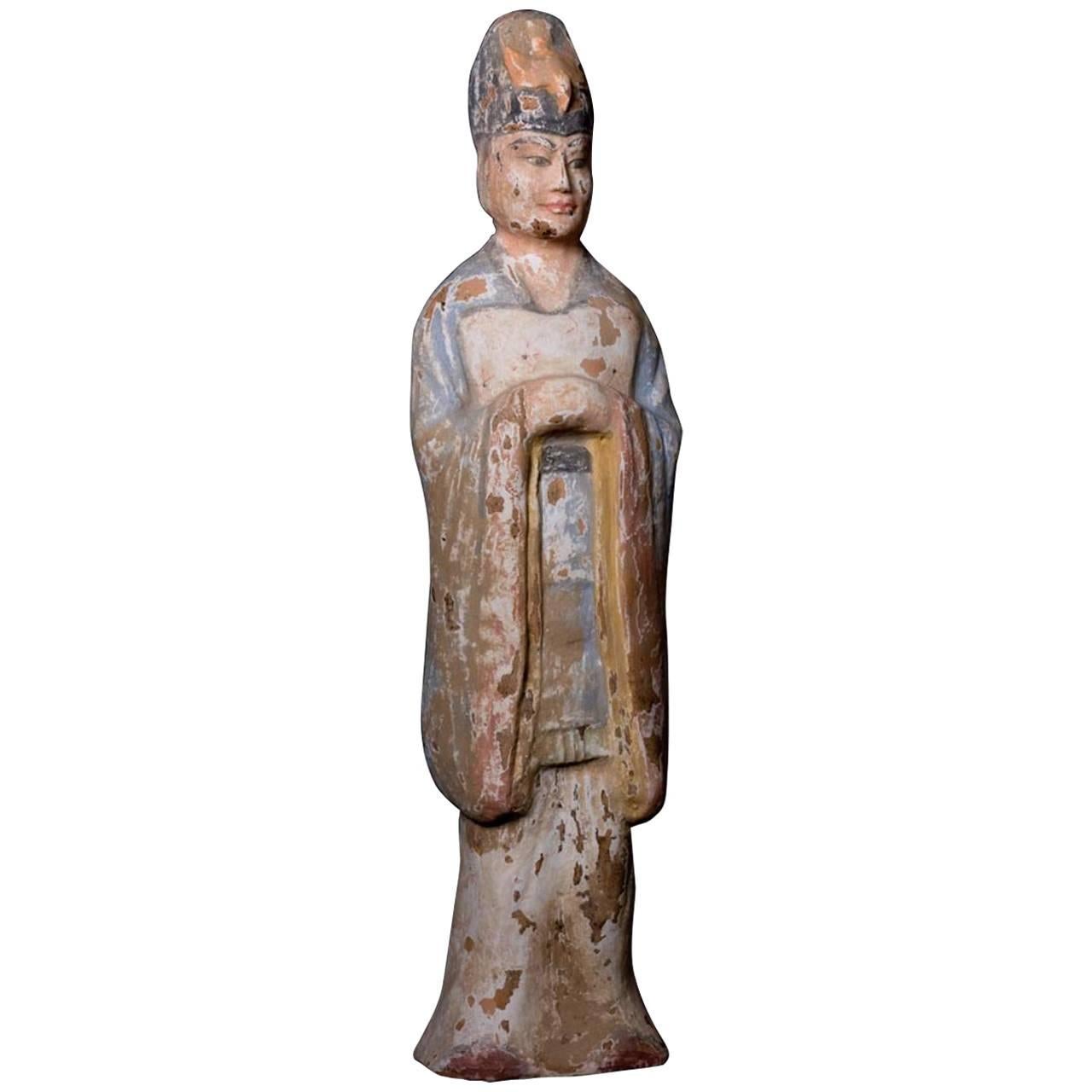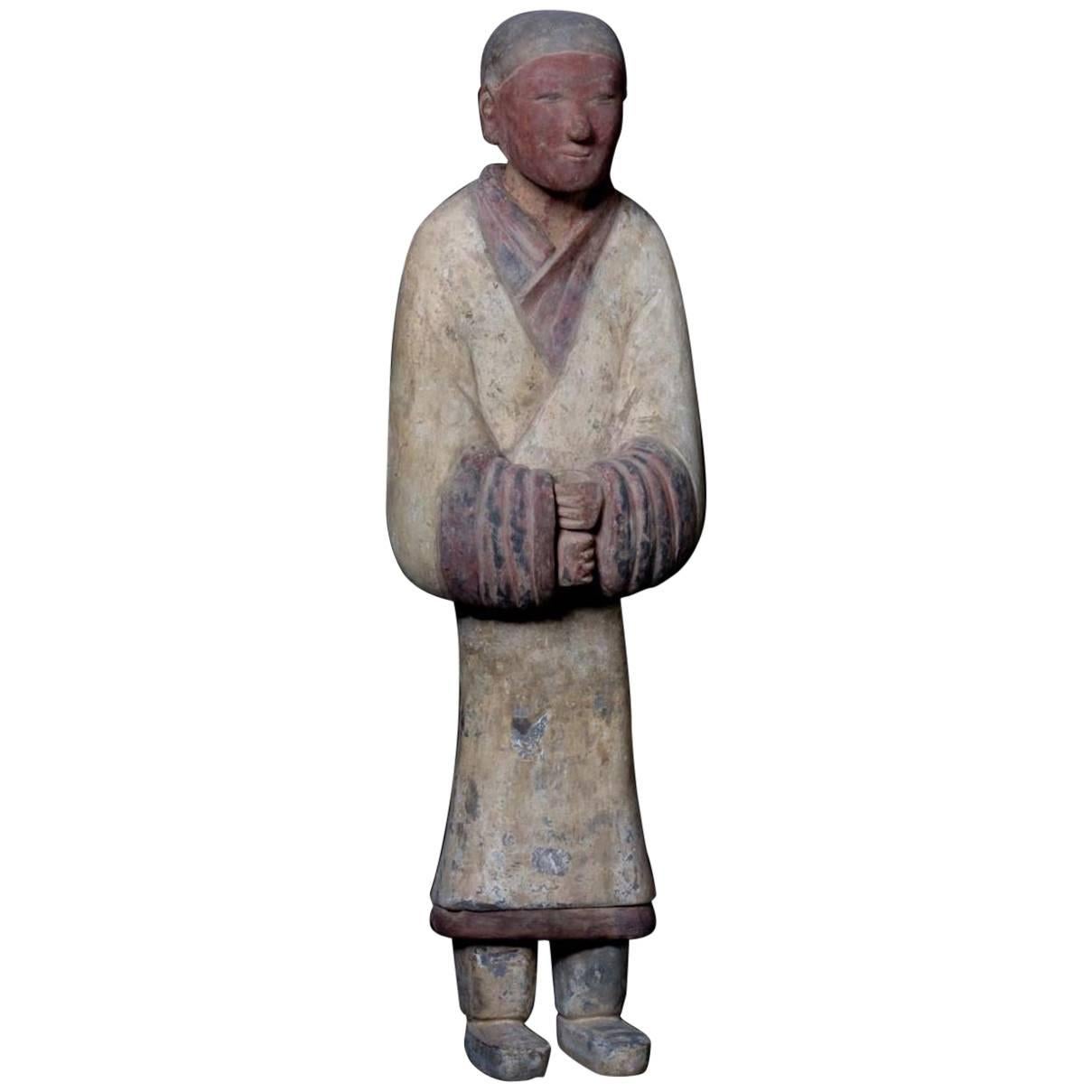Items Similar to Expressive Court Lady in Orange Terracotta - Wei Dynasty, China '386-557 AD'
Want more images or videos?
Request additional images or videos from the seller
1 of 8
Expressive Court Lady in Orange Terracotta - Wei Dynasty, China '386-557 AD'
About the Item
Lovely sitting lady from the Imperial Court with original polychrome paint in orange terracotta.
This piece is accompanied by a the following documents:
- Certificate of Expertise by Jean-Yves Nathan - Specialist in Asian Arts for the
- Certificate of Authenticity
Mingqi in the Six Dynasties (221–589A.D.)
Burial figurines of graceful dancers, mystical beasts, and everyday objects reveal both how people in early China approached death and how they lived. Since people viewed the afterlife as an extension of worldly life, these figurines, called mingqi, sometimes referred as “spirit utensils” or “vessels of ghosts” disclose details of routine existence and provide insights into belief systems over a thousand-year period.
The symbiotic relationship between individual and state, as well as between life and afterlife, meant that tombs underwent dramatic changes after the Han’s central authority weakened and ultimately collapsed in 220 A.D. The period of disunion that followed, known as the Six Dynasties (220–589), saw an immediate reaction against ornate tombs, which were considered emblematic of excesses responsible for the downfall of the Han. Even imperial tombs were spare, reflecting ideology as well as economic realities in unstable times. The overall number of mingqi, as well as their quality, declined in the early Six Dynasties.
In southern China, people turned to Daoism, and mingqi, as well as above-ground sculptures, became ever more infused with animal iconography and energized with dynamic lines.
The north of China was eventually united by nomadic Tuoba invaders who founded the Northern Wei dynasty (386–534) and established a measure of stability. Their rule fostered both preservation, seen in Han tomb styles and funerary practices, as well as innovation, seen in new types of mingqi such as human-faced guardian animals called zhenmushou, human guardians, and increasing numbers of pack animals and military figures.
- Dimensions:Height: 5.5 in (13.97 cm)Width: 3 in (7.62 cm)Depth: 3 in (7.62 cm)
- Materials and Techniques:
- Place of Origin:
- Period:
- Date of Manufacture:386-557 AD
- Condition:Wear consistent with age and use. Minor losses. Minor fading.
- Seller Location:San Pedro Garza Garcia, MX
- Reference Number:
About the Seller
3.7
Vetted Seller
These experienced sellers undergo a comprehensive evaluation by our team of in-house experts.
1stDibs seller since 2017
22 sales on 1stDibs
- ShippingRetrieving quote...Ships From: Laredo, TX
- Return PolicyA return for this item may be initiated within 3 days of delivery.
More From This SellerView All
- Magnificent Court Attendants in Terracotta - Ming Dynasty, China 1368-1644 AD TLLocated in San Pedro Garza Garcia, Nuevo LeonA magnificent pair of male and female courtiers from the Ming Dynasty (1368-1644 CE) in excellent condition. They are wearing traditional Daopao robes in green and black garments wit...Category
Antique 15th Century and Earlier Chinese Ming Antiquities
MaterialsTerracotta
- 6 Elegant Ming Dynasty Court Attendants in Glazed Terracotta, China 1368-1644 ADLocated in San Pedro Garza Garcia, Nuevo LeonA fine set of a six court attendants as in the Forbidden City of Beijing, elegantly dressed in a Green & Red Daopao – a traditional men’s formal attire from the Ming Dynasty dated 1368-1643 A.D. – with glazed robes and Red Pigment remains in their hat and belts. They stand in an honorary posture atop a red plinth, some with orifices in their hands, where spirit objects were placed to comfort or satisfy the deceased. The heads are detachable, as often seen on the larger figures from this period. They are accompanied by a Certificate of Authenticity, and Certificate of Expertise by Jean-Yves Nathan - a leading authority specialized in Far East Archaeology from the CEDEA (The European Confederation of Art Experts). Burial figurines of graceful dancers, mystical beasts, and everyday objects reveal both how people in early China approached death and how they lived. Since people viewed the afterlife as an extension of worldly life, these figurines, called mingqi, sometimes referred as “spirit utensils” or “vessels of ghosts” disclose details of routine existence and provide insights into belief systems over a thousand-year period. The Ming dynasty was the ruling dynasty of China – then known as the Empire of the Great Ming – for 276 years (1368–1644 AD). Founded by Chu Yuan-chang, the rebel leader that was successful in removing the mongols from the throne. Chinese control was re-asserted in China and eastern Asia. Literature became more important, schools were created, and the justice system was reformed. The Ming dynasty is described by some as "one of the greatest eras of orderly government and social stability in human history,” was the last imperial dynasty in China ruled by ethnic Han Chinese. The practice of burying ceramic objects with the deceased went into decline from the 10th to the 14th Century AD. There was a revival in placing miniature representations of glazed terracotta objects such a furniture, food offerings, horses, miniature statues...Category
Antique 15th Century and Earlier Chinese Ming Antiquities
MaterialsTerracotta
- Very Elegant Tang Dynasty Dignitary in Orange Terracotta, China '618-907 AD'Located in San Pedro Garza Garcia, Nuevo LeonVery elegant terracotta dignitary in blue and red robes standing with the hands joined at the chest. He wears a blue headdress with a bird at its center. Orange Terracotta This gorg...Category
Antique 15th Century and Earlier Chinese Tang Antiquities
MaterialsTerracotta
- Elegant Han Dynasty Terracotta Warrior - China '206 BC - 220 AD'Located in San Pedro Garza Garcia, Nuevo LeonImpressive terracotta warrior representing a banner bearer gripping a wooden staff with his hands (dematerialized through the ages); his gaze is ser...Category
Antique 15th Century and Earlier Chinese Han Antiquities
MaterialsTerracotta
- Chimera (Pixiu) Terracotta Mythological Being - Tang Dynasty, China '618-907 AD'Located in San Pedro Garza Garcia, Nuevo LeonMagnificent Mythological Being "Chimera" with Human Face and Flaming Rays Halo. Orange Terracotta with Traces of Stucco and Painting. This creature is commonly known as Pixiu. Fierc...Category
Antique 15th Century and Earlier Chinese Tang Antiquities
MaterialsTerracotta
- Monumental Han Dynasty Terracotta Horse - TL Tested - China, '206 BC–220 AD'Located in San Pedro Garza Garcia, Nuevo LeonA massive pottery horse with separately made head and tail, standing on all fours and striding with its right hoof forward. Extended snout ends in parted lips showing teeth beneath i...Category
Antique 15th Century and Earlier Chinese Han Antiquities
MaterialsTerracotta
You May Also Like
- Chinese Pottery Camel, Northern Wei Dynasty (386 - 535 AD), China, TL TestedLocated in Austin, TXA delightful and rare Chinese painted high fired gray pottery model of a wooly camel, Northern Wei Dynasty (386 - 535 AD), China, with TL test. The charming camel is portrayed stand...Category
Antique 15th Century and Earlier Chinese Antiquities
MaterialsPottery
- Tang Dynasty, Antique Chinese Pottery Standing Court ManLocated in Sampantawong, THChinese pottery standing court man wearing hat and tunic. Age: China, Tang Dynasty, A.D. 618 - 907 Size: Height 22 - 22.2 C.M. / Width 6.1 - 6.2 C.M. ...Category
Antique 15th Century and Earlier Chinese Antiquities
MaterialsPottery
- China Ancient Stone Entertainer, Han Dynasty 200 ADLocated in South Burlington, VTChina an ancient limestone figure of an Entertainer replete with hands holding tambourines and a top a drum, -for the afterlife- , Han dynasty 206 BC...Category
Antique 15th Century and Earlier Chinese Han Sculptures and Carvings
MaterialsLimestone
- Ming Dynasty, A Set of Antique Chinese Pottery Court ManLocated in Sampantawong, THA set of Chinese pottery standing court man. Age: China, Ming Dynasty, A.D. 1368 - 1644 Size: Height 25.9 - 27.4 C.M. / Width 8.9 - 9.1 C.M. Condition: well-preserved old burial...Category
Antique 15th Century and Earlier Chinese Antiquities
MaterialsPottery
- Antique Han Dynasty Chinese Painted Pottery Kneeling Court AttendantLocated in Sampantawong, THChinese painted pottery kneeling court attendant. Age: China, Han Dynasty, 206 B.C. - A.D. 220 Size: Height 18.8 C.M. / Width 8.4 C.M. / Thickness...Category
Antique 15th Century and Earlier Chinese Antiquities
MaterialsPottery
- Tang Dynasty, Antique Chinese Pottery Standing Foreign Court ManLocated in Sampantawong, THChinese painted pottery standing foreign court man, bulging eyes, high nose, wearing hat, with red black, and white pigments remaining. Age: China, Tang Dynasty, A.D. 618 - 907 Size...Category
Antique 15th Century and Earlier Chinese Antiquities
MaterialsPottery





